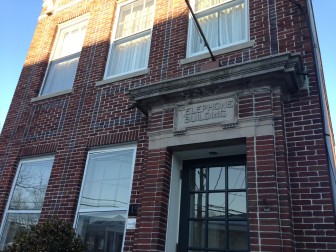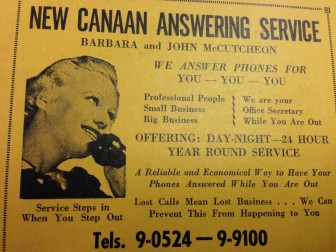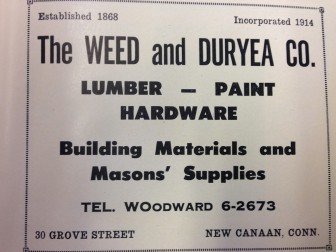New Canaanites today see residents on cellphones everywhere, driving up Ponus Ridge (hopefully not doing this) or walking along the sidewalks of Elm and Main.
For people such as Cookie King, née Van Beck—who lived in New Canaan from the 1930’s to the 1960’s and whose family lived in New Canaan until 1995—that’s about as impersonal as the way individual cell numbers are assigned: Between IP technology and mobile provider pool applications, there’s no rhyme or reason to a New Canaan “extension.”
“We still have a landline and won’t give it up,” King told NewCanaanite.com “Have phone on the wall with a dial on it too.”
Many New Canaanites remember the days even before “966” was the town’s main designated exchange, and a look at our local telephone history tells the story of those three digits, long associated with the Next Station to Heaven.
The first telephones in New Canaan were installed in 1881, as four businesses in the then-small town—Henry B. Rogers & Co., Hoyt’s Nurseries, Monroe’s drug store and Johnson’s carriage works—were part of the Norwalk exchange.

The Telephone Building on Main Street. (Terry Dinan photo)
After the turn of the century, New Canaan’s population began growing rapidly—as did the number of phones in town. Switching equipment had been operated in private homes, but with the construction of the two-story Telephone Building on Main Street completed in 1913, the Southern New England Telephone Company had a centralized location to establish a New Canaan exchange.

Karl Chevrolet's number is still technically “WO 6-9508.” You just have to dial it as “(203) 966-9508.”
By the mid-1930s there were nearly 2,000 phones in town. That said, many numbers were short and easy to remember. For instance of you wanted to inquire about a 1938 Chevy, you could contact Karl Chevrolet by asking for “New Canaan 903.” If a Ford fit your fancy, you could ask for an appointment at the Kaiser dealership on South Avenue by calling “New Canaan 468.” If you wanted to know what time Silliman’s Hardware was closing, you could connect to “New Canaan 40.”
 When the 1940s rolled around, New Canaan followed the Stamford and Norwalk examples of including a unique numerical prefix followed by a four-digit number. New Canaan’s prefix was 9, so if someone wanted to call Breslow’s on Elm Street, they could dial either 9-9021 or 9-9022. And in the age before texting and answering machines, local businesses such as Barbara and John McCutcheon’s New Canaan Answering Service could ensure that no call was a lost call.
When the 1940s rolled around, New Canaan followed the Stamford and Norwalk examples of including a unique numerical prefix followed by a four-digit number. New Canaan’s prefix was 9, so if someone wanted to call Breslow’s on Elm Street, they could dial either 9-9021 or 9-9022. And in the age before texting and answering machines, local businesses such as Barbara and John McCutcheon’s New Canaan Answering Service could ensure that no call was a lost call.
By the mid-50s, New Canaan had more than 4,000 phones and all would need to adapt to another evolution in the exchange. For many years, cities across the nation used alphanumeric exchanges—famously immortalized in songs “PEnnsylvania 6-5000” and “BEechwood 4-5789”) as well as television (Lucy and Ricky Ricardo’s number was “MUrray Hill 5-9975” on I Love Lucy). As it does today—with slight variation—every letter in the alphabet (except Q) was mapped to a corresponding number:
2 A B C
3 D E F
4 G H I
5 J K L
6 M N O
7 P R S
8 T U V
9 W X Y
0 Z
For towns such as New Canaan that were being added to the alphanumeric format,  SNET’s parent company AT&T developed a recommended list of generic exchange names with the hope that they would limit the amount of confusion when spoken. New Canaan was assigned “WOodward-6,” so someone calling Weed and Duryea in 1956 would dial “WO 6-2673” and if you wanted to trade in that old ’38 Chevy for something a little more modern, Karl Chevrolet could still be reached, albeit with a different number – “WO 6-9508.”
SNET’s parent company AT&T developed a recommended list of generic exchange names with the hope that they would limit the amount of confusion when spoken. New Canaan was assigned “WOodward-6,” so someone calling Weed and Duryea in 1956 would dial “WO 6-2673” and if you wanted to trade in that old ’38 Chevy for something a little more modern, Karl Chevrolet could still be reached, albeit with a different number – “WO 6-9508.”
“It was distinctive, easy to remember and would not be confused with other names,” said Janet Lindstrom, executive director of the New Canaan Historical Society.
Distinctive as it was, the new exchange did not last long. Phone service demand grew in the post-war baby boom years, and this need quickly exceeded the capacity that the alphanumeric format afforded. The addition of area codes and long distance calling helped to expedite its demise. By 1963, WO-6 was phased out, replaced by “966”—the corresponding numerals on the original mapping plan.
For Cookie King, the exchange jumping was not a smooth transition.
“I remember changing from 9-0210 to WO 6-0210 to 966-0210,”said King. “The new number was annoying to dial and remember what to dial. I guess times change and so do phone numbers.”
Eventually the “966” exchange became part of New Canaan’s identity. A recent discussion thread started by King on Facebook’s “If you’re really from New Canaan you’d know…” group generated more than 100 comments with current and former residents sharing their past phone numbers, many of which dated back to pre-“WOodward” years.
“I too cannot remember where I put my car keys one day to the next,” wrote one member of the Facebook group. “But I remember those and other numbers.”
Additional exchanges were added over the years as the population grew, starting with “972” introduced in—you guessed it—1972. And with the current trend of cellphones supplanting the need for landlines, the pool of phone numbers is certainly diluted. Even so, for most New Canaanites who lived in town for the past half-century, it is “966” that says “New Canaan” when it comes to phone calls.
I love this article. I love my landline over here in Greenwich. In fact my old rotary phone worked during the hurricane after the power had been out for days and my cell was dead!